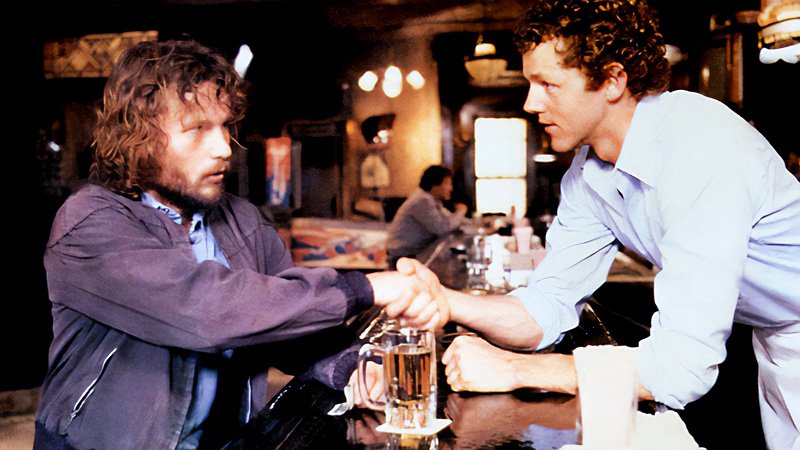
John Savage and David Morse in ‘Inside Moves’ (1980)
Synopsis
All I knew about Inside Moves was the poster. An image of a scruffy, familiar-looking young actor, fist raised. Maybe a martial arts saga?
So I wasn’t expecting that first scene. Is this clean-cut guy heading into the office building for a dramatic meeting? Maybe he’s just dragging his heels on his way to a thankless job. Or is he lost? Something’s off. He cautious, nervous, glancing here and there, searching. It gels when he slips into an empty office, opens a window, looks out. You expect a dramatic, Hollywood moment: surely he’ll hesitate, music swelling, maybe take a step back, then step up to the window again. Tight, long closeup as indecision sweeps over his face. But no. He barely hesitates. Our view immediately shifts outside. He leans forward. And he lets go. It’s a convincing fall before CGI, crashing through tree branches, hitting a car roof.
And incredibly, he lives.
The guy is Roary (hey, that’s a young John Savage). Now bearded and scruffy, he emerges after months of recovery and painful physical therapy. Limping, unsteady, speaking hesitantly. Perhaps just a tad mentally impaired at first but still lucid and improving. This is where the story really begins, as Roary re-engages with the world.
It’s the San Francisco Bay Area. When? Herb Alpert’s “The Lonely Bull” is playing in Max’s Bar as Roary steps inside, so at least mid-60s. He’s in search of a beer. But he also finds a friendly barkeep, Jerry (hey, that’s a young David Morse too), who also has a limp. Jerry offers Roary a first free round and an introduction to the regular patrons.
Like Roary and Jerry, they all have some disability. One’s blind, another wheelchair-bound, another with amputated hands. These regulars play cards, watch the Golden State Warriors on the TV, tell jokes, trade insults. They ask Roary how he came to be there. He admits he tried to commit suicide, but he doesn’t say why. And they don’t ask. Roary joins the family.
The emotional weight of the story frequently falls on Jerry. His easy-going exterior demeanor masks his interior pain. He’s a bit boastful about his basketball chops, but turns out he really has moves when he challenges a Golden State Warrior to a one-on-one, barely losing. Roary wants to help Jerry get an operation that can get him back into the game. But neither of them have the cash it will take.
And the complications pile on from there. Jerry desperately wants another crack at the big time. But he’s distracted by his on-again, off-again drug-addicted girlfriend. Max, the bar owner, has a heart attack and everyone has to pull together to keep the business going. Roary and the new waitress, Louise (Diana Scarwid), seem drawn to each other, but she’s hesitant. Roary’s working on regaining his balance. And we keep wondering: what brought Roary to make that leap?
See It
The acting is uniformly fine, with director Richard Donner amping up the comedy between the patrons to keep things light, then balancing it with tense confrontations that avoid descending into melodrama. Savage does an excellent job with his character arc as Roary struggles to recover physically and emotionally. Scarwid’s remarkable presence as the woman grappling with conflicting emotions deservedly earned an Oscar nom for best supporting actress. And Morse is a standout as a character who we alternately embrace, reject, re-evaluate, and root for. And a special tip of the hat to Harold Russell, who played the wisecracking, double-amputee nick-named Wings to hilarious perfection. Russell’s last appearance was his Oscar-winning supporting role in 1946’s Best Years of Our Lives!
The key insight unfolds when Roary finally confesses why he tried to end his life. No overblown, dramatic soundtrack. Emotion, but no gushing river of tears. It’s nothing monumentally dramatic. That’s the point. Why he did it doesn’t matter. What mattered was how he dealt with it later. As the finale approaches and he vacillates between going one direction or another, we genuinely wonder which it will be.
In that moment, you get an uneasy feeling. They’ve done such a good job of telling a gritty story that’s, ok, yes … it’s sentimental … but not condescendingly melodramatic. Will they go the distance with a thought-provoking finale, or will they pull their punches and go for the Hollywood closer?
You’ll have to judge how the ending suits you.